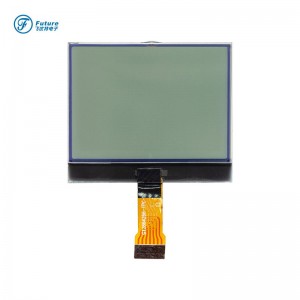128×64 Dot Matrix Lcd Display, Fstn Lcd Display,128×64 STN Lcd Display,
Our products are used for widely applications, such as industrial controller, medical device, electric energy meter, instruments controller, Smart home, home automation, automotive dash-board, GPS system, Smart Pos-machine, Payment Device, white goods, 3D printer, coffee machine, Treadmill, Elevator, Door-phone, Rugged Tablet, Thermostat, Parking system, Media, Telecommunications etc.
| Model NO | FG12864266-FKFW-A1 |
| Resolution: | 128*64 |
| Outline Dimension: | 42*36*5.2mm |
| LCD Active Area(mm): | 35.81*24.29mm |
| Interface: | / |
| Viewing Angle: | 6:00 o'clock |
| Driving IC: | ST7567A |
| Display Mode: | FSTN/POSITIVE/TRANSMISSIVE |
| Operating Temperature: | -20 to +70ºC |
| Storage Temperature: | -30~80ºC |
| Brightness: | 200cd/m2 |
| Specification | RoHS, REACH, ISO9001 |
| Origin | China |
| Warranty: | 12Months |
| Touch Screen | / |
| PIN No. | / |
| Contrast Ratio | / |
FAQ
1, What is TN LCD?
TN LCD (Twisted Nematic Liquid Crystal Display) is a type of LCD technology commonly used in digital displays, televisions, computer monitors, and mobile devices. It is known for its quick response times, high brightness, and low manufacturing costs. TN LCDs use liquid crystal molecules that rotate in a twisted configuration when an electric current is applied to them. This type of LCD technology is widely used due to its affordability, but it typically offers limited viewing angles and lower color accuracy compared to other LCD technologies like IPS (In-Plane Switching) and VA (Vertical Alignment).
2, What is STN LCD?
STN LCD (Super-Twisted Nematic Liquid Crystal Display) is a type of LCD technology that is an advancement of TN LCD. It improves upon the color and contrast capabilities of TN LCDs, while also offering lower power consumption. STN LCDs use a super-twisted nematic structure which allows for better control of the liquid crystal molecules, resulting in improved image quality. The super-twisted nematic structure creates a helical alignment of the liquid crystals, which helps to enhance the display's viewing angles and provide higher levels of contrast and color saturation. STN LCDs are commonly used in devices such as calculators, digital watches, and some early generation mobile phones. However, it has largely been phased out by more advanced LCD technologies such as TFT (Thin Film Transistor) and IPS (In-Plane Switching).
3, What is FSTN LCD?
FSTN LCD (Film-compensated Super Twisted Nematic Liquid Crystal Display) is an improved version of STN LCD technology. It utilizes a film compensation layer to enhance the display's performance. The film compensation layer is added to the STN LCD structure to reduce the gray scale inversion problem that often occurs in traditional STN displays. This gray scale inversion problem leads to reduced contrast and visibility when viewing from different angles.
FSTN LCDs offer improved contrast ratios, wider viewing angles, and better display performance compared to STN LCDs. They can display both positive and negative images by adjusting the voltage applied to the liquid crystal cells. FSTN LCDs are commonly used in applications where high contrast and good viewing angles are required, such as in smartwatches, industrial control panels, and medical devices.
4, What is VA LCD?
VA LCD stands for Vertical Alignment Liquid Crystal Display. It is a type of LCD technology that uses vertically aligned liquid crystal molecules to control the passage of light.
In a VA LCD, the liquid crystal molecules align themselves vertically between two glass substrates when no voltage is applied. When a voltage is applied, the molecules twist to align horizontally, blocking the passage of light. This twisting motion allows VA LCDs to control the amount of light that passes through and thus create different levels of brightness or darkness.
One of the key advantages of VA LCD technology is its ability to achieve high contrast ratios. The vertically aligned liquid crystal molecules and the control of light passage result in deep blacks and brighter whites, leading to a more vibrant and lifelike display. VA LCDs also offer wider viewing angles compared to TN (Twisted Nematic) LCDs, although they may not match the viewing angles of IPS (In-Plane Switching) LCDs.
Due to their excellent contrast ratios, good color reproduction, and wider viewing angles, VA LCDs are commonly used in high-end televisions and computer monitors, as well as in some mobile devices, gaming consoles, and automotive displays.
-

Phone
-

E-mail
-

Whatsapp
-

Top









